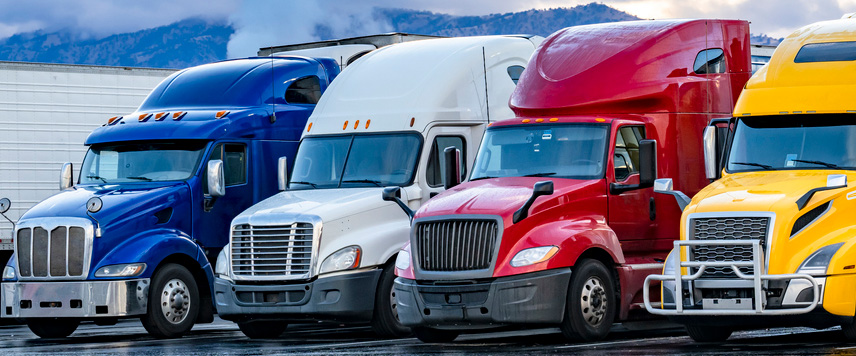When someone who isn’t involved in the trucking profession thinks about truck drivers, it can be difficult to picture anything other than what we perceive to be the stereotypical trucker: alone for long hours on the road, driving as quickly as possible from one region to another with their semi-trucks full of cargo. It is rare that truckers are considered part of a greater force of men and women; the lone wolf on the road image has gone far. However, many people forget that truck drivers used to be a heavily unionized force, complete with union management and organization. In 1901, when transporting freight still involved trains and horse-drawn carts, almost two thousand truckers banded together to form the Team Drivers International Union. Even though they were quickly absorbed into a new organization called the International Brotherhood of Teamsters, for almost eighty years, truck drivers depended on the support of a union to help them control their pay and the routes they had to drive. So, what happened? Why are unions not as prevalent in the trucking industry today, and is that a good thing or a bad thing for truck drivers and trucking companies?
It was a “team” effort in the beginning…
Before the 1980s (back in the long ago, the Dark Ages, the time before time… Ask any Gen Alpha when the 80s were and this is what they’ll tell you.), many truck drivers, as stated above, joined the Teamsters and were part of a well-organized machine that negotiated their salaries, vacation time, and even the routes they would drive. Truck driving was considered a solid career for men without college degrees. The average trucker could expect to work forty to fifty hours per week, with pay for overtime. Many drivers could expect to be able to afford a home, and they could stick back enough money to send their children to college before being able to retire with a pension. The work has always been difficult, but, from the time trucking unions became commonplace, and up until the 1980s, the financial compensation would make it worth it. For decades, if truck drivers had any concerns, they could take it to their union contact, who would take it to the Teamsters and have them sort it out with management. If issues couldn’t be resolved easily, the union would take action, including calling for strikes and walkouts from other truckers. In 1970, a nationwide, month long strike led to the negotiation of a 30% raise for all Teamster truck drivers. For a long time, the partnership was in the best interest of everyone from drivers to politicians to company owners to even consumers who grew to depend on trucking for the hauling of food and goods.
Throughout the 1970s, the trucking industry was heavily controlled by mafia interests, and, while it wasn’t noticed immediately, there were those who railed against what the union had become. Jimmy Hoffa, who was president of the Teamsters from 1957 to 1971, made his mark by helping create the first national freight-hauling agreement. However, his presidency of the union was noted for its corruption and scandal, and Hoffa even spent some time in prison while still running the Teamsters. As mobsters and the mafia had their roles in unions uncovered by reporters and government officials, many average Americans began to lose faith in unions. By the end of the disco decade, not only had Jimmy Hoffa disappeared (There are still people looking for him.), but most unions had declined in popularity. Truck drivers, who are normally more conservative leaning, were some of the first to be disillusioned with the way organized crime seemed to have infiltrated the industry. From there, it was not long before the government stepped in to attempt to take control of the situation.
The Motor Carrier Act of 1980 was signed into effect by the Carter administration. Originally, the goal was to remove regulations that costs the consumers additional money. The high trucker salaries and limited routes meant that the costs of household goods were high. After the rampant inflation of the late 70s, President Jimmy Carter led the charge for the MCA, and, seemingly overnight, new trucking companies could open without dealing with the Teamsters union, offering new routes for less pay and fewer restrictions. All of a sudden, goods cost less, and companies could pay their drivers less to transport the goods anywhere in the country. When the bill was signed, the president said that buyers would be able to save as much as $8 billion a year, and that’s in 80s money!
No more “striking” while the iron is hot…
So, what happened to trucking companies after the passage of the Motor Carrier Act? Some of the immediate effects included a drastic drop in union membership. In 1974, membership in the Teamsters numbered over two million. As of 2019, there were roughly 75,000 truckers with a membership to the Teamsters union. A truck driver’s average earnings also fell by 24%, with that number being as high as 35% in some metropolitan areas. Not only did truckers lose their standardized pay, but, with the loss of the organization provided by the unions, truck drivers lost much of their ability to go on strike. Resulting in the industry we see today, the loss of the overarching control of the Teamsters has led to changes that affect everyone from the drivers to the consumers.
Not all truck drivers are pro-union, and, as we’ve seen from the 1970s, not all unions keep the workers at the forefront of their efforts. For over forty years, the trucking industry has struggled between trying to offer their drivers enough compensation to keep them from joining unions and keeping the costs low enough to pass on to consumers, so they continue to buy the things being transported. However, with an uptick since 2018, truck drivers have been attempting to band together for higher wages, better hours, and more safety features for their trucks. With their ability to strike greatly hampered by federal trucking rules and regulations, though, it has been difficult to get the publicity or influence to make any serious changes.
Some companies had been holding on to the tradition of having unionized truck drivers. Companies like Yellow Freight were known to have many union drivers, but, in recent years, when all of the negotiations were complete for higher pay, the additional hourly money never came. Yellow declared bankruptcy and closed this very year; some, like the president of the National Association of Small Trucking Companies, David Owens, blamed the Teamsters for forcing the company to close because they couldn’t afford the raises. He even went as far as to say that the union “broke Yellow.” With that cloud lurking in the background, a small, and recently acquired, division of Werner voted to unionize a month after Yellow closed. The CEO of Werner met with the workers to try and convince them to give management more time to deal with the issues they brought up, but it was to no avail. However, while the workers’ vote to unionize happened very quickly for this group, there are many miles to go before unionization is complete. For the small division of Werner, known as ECM, no contracts have been agreed upon and no dues have been paid yet.
Conclusion
There are many varying and differing opinions on the roles and responsibilities of labor unions in the modern American workforce, and their status seems to be in a state of flux amongst truck drivers. It is important for management and drivers to look beyond the stereotypes to see what unions, like the Teamsters, actually provide. Even with that, there are pros and cons to having a company’s workers unionize. While there are possibilities of a negotiated higher wage and better benefits for truckers, there are also union dues and the loss of personal decision making when it comes to work when one joins a union.
The key for a trucking company’s leadership to avoid having a shop unionize is to keep as many lanes of communication open between management and drivers as possible. The better these two groups work together, the more they can foster trust in each other, and, in the end, everyone can work towards solutions to issues together, instead of being forced into a position where unionized drivers walk away from their trucks. At this time, while strikes are being planned and executed by healthcare workers, actors, and many more, truck drivers are in a precarious position. Recently, the Supreme Court sided with a concrete company after their drivers walked away from their full trucks, causing the concrete to dry inside of them and damaging the trucks. While they may have had good reasons for walking off of the job, they lost any of their negotiating ground by being made liable for causing thousands of dollars in damages. This decision will hamper further attempted trucker strikes for the foreseeable future, but it does not mean that drivers should be treated with anything less than respect and dignity.
__________________________________________________________________________
Meaghan Goldberg covers recruitment and digital marketing for Lionzone. A Patterson, GA native, after graduating from both Valdosta State University and Middle Tennessee State University, Meaghan joined Lionzone in 2018 as a digital recruitment strategist before becoming the social media manager.
Resources:
https://www.freightwaves.com/news/a-first-for-werner-small-group-of-workers-votes-to-unionize
https://www.businessinsider.com/trucking-truck-driver-truckers-strike-reasons-2019-10
https://www.thetruckersreport.com/news/pros-cons-working-truck-driver-union-shop/




